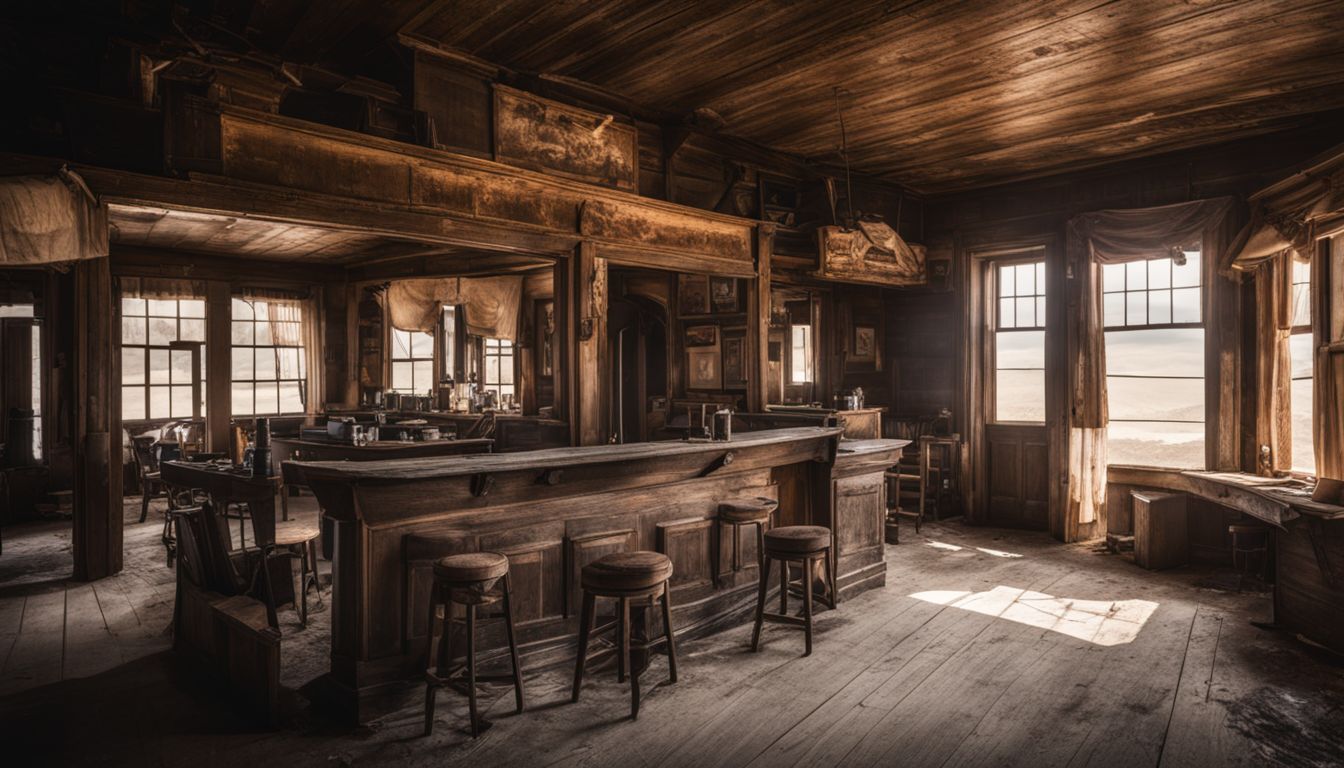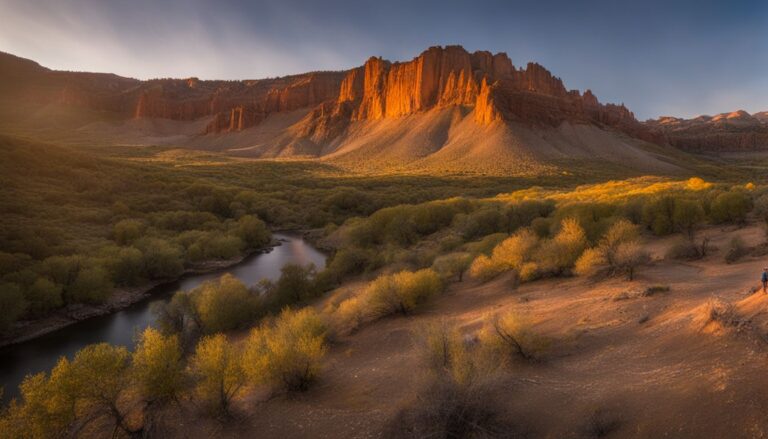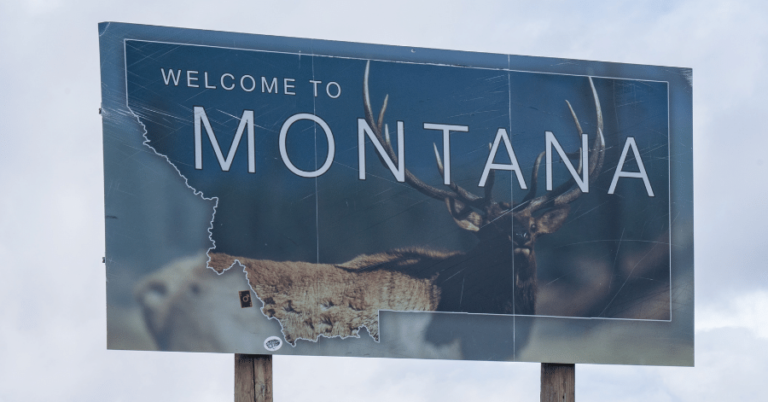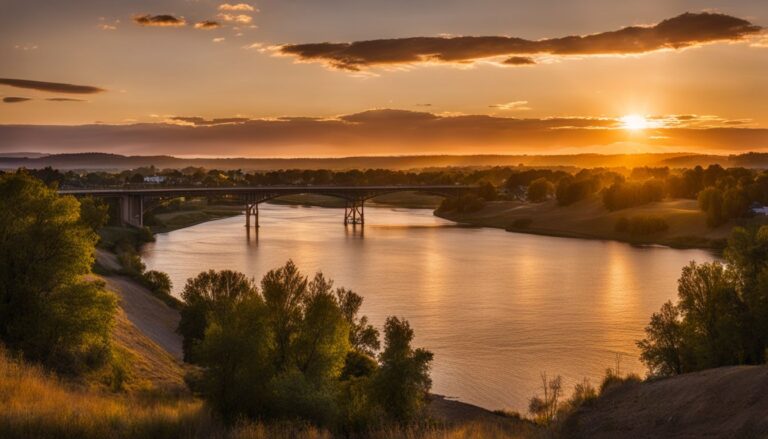Exploring Montana Ghost Towns: Uncovering The Wild West History
Montana Ghost Towns
There’s something irresistibly charming about the idea of stepping off the beaten path and into the quiet whispers of small towns. Many of us crave such escapes, seeking solace in places where history still breathes through every nook and cranny.
If you’re one to yearn for a journey that takes you back to the thrilling days of gold rushes and wild western lore, then Montana’s ghost towns are calling your name. In this article, we’ll guide you through these hidden gems, sharing tales steeped in adventure and mystery from their glory days.
So buckle up; an unforgettable exploration awaits!
Key Takeaways
- Montana’s ghost towns, such as Bannack and Nevada City, sprung up during the gold rush in the 1800s but quickly became deserted when mines dried up. These towns offer a peek into the Wild West era.
- The mining boom brought prosperity but also lawlessness. Communities formed vigilante groups to protect themselves because official law enforcement was scarce or ineffective.
- Today, over 60 original buildings remain in Bannack State Park, allowing visitors to step back in time. Other ghost towns like Garnet and Comet also offer well-preserved remnants of their past.
- Exploring these ghost towns not only provides insight into Montana’s rich history but also supports preservation efforts for future generations to learn from and enjoy.
- Visitors should prepare for rugged terrain with sturdy footwear and plan trips during summer months for better weather conditions while respecting historical sites by not damaging or removing artifacts.
The Fascinating History of Montana Ghost Towns

Montana’s ghost towns tell a riveting tale of the Wild West, characterized by the boom and bust of mining towns and its lawless nature. The rise and fall of these settlements are emblematic of the untamed frontier spirit, offering a captivating glimpse into Montana’s rich historical heritage.
Boom and Bust: The Rise and Fall of Mining Towns
Mining towns sprang up across southwest Montana as people rushed in search of gold. These towns grew fast, filled with miners dreaming of striking it rich. Streets once quiet quickly filled with the sounds of construction, prospectors, and saloons bustling with hopefuls discussing their finds.
But this rapid growth didn’t last forever. As easily as gold was found, mines began to dry up, leaving towns empty and abandoned almost as quickly as they were built.
The cycle of boom and bust left behind ghost towns dotted throughout the region. Each town tells a story of hope, hardship, and the relentless pursuit for wealth under the big Montana sky.
Families moved on in search of new opportunities while wooden buildings aged silently against time’s test.
Lawlessness and Vigilantes in the Wild West
We’ve explored these ghost towns and seen firsthand the tales of lawlessness and vigilante justice that defined the Wild West. Gold sparked rapid growth in towns across Montana, drawing miners, entrepreneurs, and those seeking new beginnings.
Yet, where wealth and opportunity gathered, so did crime and disorder. Towns barely kept pace with their growing populations, leading to a vacuum in law enforcement. This chaos often meant that justice was swift and brutal, carried out by self-appointed vigilantes.
In response to thieves, bandits, and unscrupulous characters preying on hardworking folks, communities banded together forming groups known as Montana Vigilantes. They took matters into their own hands to protect property and lives when official law enforcement was either unavailable or ineffective.
Their actions were controversial but reflected the harsh realities of frontier life. Such experiences offer us a glimpse into a past where survival often depended on mutual support within these isolated communities amid the challenges posed by an untamed landscape.
Top 12 Ghost Towns to Visit in Montana

Explore the top 12 ghost towns scattered across Montana, including Bannack, Nevada City, and Fort Assiniboine. Uncover the rich history behind each town and envision life in the Wild West through a visit to these intriguing destinations.
1. Bannack
Bannack sits in western Montana as a window to the past, where gold once lured prospectors by the thousands starting in 1862. This town quickly became the first capital of the Montana Territory, marking its place in history.
Today, visitors can walk through Bannack State Park and see over 60 original buildings from those days of glory and despair. Each structure tells a story of hope, hard work, and sometimes heartache.
The Meade Hotel stands proudly among these relics, its walls still covered with original wallpaper that whispers tales from long ago. Its grand spiral staircase offers a glimpse into what life might have been like during Bannack’s bustling heydays.
Stepping into Bannack is like stepping back in time to experience the Old West firsthand — an adventure we all can enjoy.
2. Nevada City
Nevada City, the first capital of the new Montana Territory, was founded in 1862 and offers a chance to step back in time to experience the Montana frontier gold rush. This quaint ghost town is associated with uncovering Wild West history and exploring Montana’s fascinating past.
It was where the notorious Sheriff Henry Plummer met his end at the hands of the Montana Vigilantes, adding to its mysterious allure. Nevada City stands as one of the top 12 ghost towns in Montana and provides a unique glimpse into the state’s captivating history during the mid-to-late 1800s gold rush era.
3. Fort Assiniboine
Fort Assiniboine, established in 1879 and closed in 1911, sprawled across 704,000 acres with a total of 104 buildings. The fort’s rich history offers visitors a glimpse into the life of early settlers and the intricate workings of a military installation from that era.
Its expansive grounds beckon history enthusiasts to wander among the well-preserved remnants of this once-thriving establishment. Walking through the fort allows us to step back in time as we explore its barracks, officers’ quarters, stables, and other historical structures.
The scale and depth of Fort Assiniboine’s historical remains offer a captivating experience for those seeking an authentic connection to Montana’s past. As we ponder over how daily life played out within these historic walls, our understanding deepens about the realities faced by early inhabitants shaping this region’s narrative.
4. Kendall
Kendall, Montana was a bustling mining town in the early 1900s, drawing up to 1,500 residents at its peak. Today, it stands as one of the top 12 ghost towns worth visiting in Montana.
The rich history and remnants of Kendall’s glory days offer a unique glimpse into the exciting but challenging life during the gold rush era. This makes it an ideal stop for history enthusiasts seeking an authentic experience of Montana’s wild west past.
The allure of Kendall lies in its well-preserved structures and artifacts that speak volumes about its former prosperity. Visitors can immerse themselves in the ambiance of this historic site, gaining firsthand insights into what life was like back when prospectors flocked to these rugged terrains in search of fortune.
5. Giltedge
Giltedge, Montana, founded in 1883, is a must-visit ghost town as it holds a significant place in the mining history of Montana. The Giltedge mine, operational from 1892 to 1991 and employing cyanide processing, produced around three tons of gold.
This historic town offers an intriguing look into the evolution of the mining industry and its impact on local communities. For those seeking to explore quieter and smaller towns with rich historical significance, Giltedge promises an enriching experience rooted in the Wild West’s bygone era.
6. Garnet
Garnet, a once bustling gold mining town that rose to prominence in 1876, offers a fascinating glimpse into Montana’s Wild West history. The well-preserved buildings and artifacts vividly portray the challenges and triumphs of the town’s early inhabitants.
As we wandered through this living museum, we marveled at the restored schoolhouse and learned about the lives of Garnet’s former residents through interpretive displays. Exploring the picturesque landscapes surrounding Garnet added an extra layer of adventure to our visit.
The granite deposits in Garnet revealed insights into the mining techniques used during its heyday. Walking along the narrow streets lined with weathered structures felt like stepping back in time, allowing us to experience firsthand what life was like for those who sought their fortunes in this rugged terrain.
7. Marysville
Marysville, a once-thriving gold mining town established around 1876, offers a captivating step back in time to the era of gold, saloons and vigilantes. Once home to Irishman Thomas Cruse’s Drumlummon Mine, which produced over $50 million in gold, Marysville boasts several National Historic Register-listed buildings.
This makes it an ideal destination for history enthusiasts looking to explore Montana ghost towns and uncover the Wild West legacy of the region. Additionally, given its rich history and mystery, Marysville is a perfect stop for those seeking more than just ordinary travel experiences – making it an excellent addition to your itinerary for experiencing the Halloween season or embarking on a comprehensive ghost town route that includes over a dozen intriguing destinations.
The historical allure of Marysville unlocks secrets from Montana’s past as you navigate through its meticulously preserved remnants of the Wild West era. As you delve into this historically significant site, picture yourself immersed in tales of gold rushes and vigilante justice that have underpinned American frontier lore for centuries.
8. Virgelle
Virgelle, settled in 1912 by homesteaders along a Great Northern Railroad spur, is a small town with significant historical appeal. As one of the top 12 ghost towns to visit in Montana, Virgelle offers a unique glimpse into the Old West era and the boom and bust period.
The town’s association with exploring Montana’s ghost towns and uncovering the Wild West history makes it an integral part of Southwest Montana’s rich heritage. When visiting Virgelle, be prepared to immerse yourself in its history and experience firsthand the captivating remnants of this once-thriving community.
9. Elkhorn
Elkhorn was once a bustling mining town with everything from hotels and bowling lanes to a post office, hundreds of homes, and even a school and church. The Fraternity Hall and Gillian Hall make up Montana’s smallest state park in Elkhorn.
This historic gem is associated with the top 12 ghost towns to visit in Montana, offering a step back in time to the era of gold rushes, saloons, and vigilantes. More than 20 historic buildings still stand here, reflecting the region’s rich heritage.
At its peak, Elkhorn had a population of 2,000 people working the mines or mining the miners. Amidst ongoing mining activities today, it remains a thriving example of America’s Wild West history.
10. Granite
Granite Ghost Town State Park in Philipsburg, Montana, holds the honor of being the site of Montana’s first major gold discovery in 1862. This ghost town was once bustling with around 3,000 residents and thrived on the wealth generated by its silver mine.
At its peak, this mine yielded a remarkable $40 million in silver, making it one of the richest in history.
Today, Granite stands as a haunting reminder of Montana’s Wild West era. Visitors can explore the remnants of this once-vibrant community and imagine life during its heyday. The park offers an insightful window into a pivotal period in American history and is well worth exploring for anyone fascinated by tales from the Old West.
11. Castle Town
Castle Town, incorporated in 1891, once bustled with 2,000 residents engaged in mining. The town boasted a school, jail, shops, and an impressive tally of seven brothels and 14 saloons.
Notably, Western legend Calamity Jane called Castle Town home at one point. Unfortunately, the Silver Panic of 1893 led to a decline from which the town never recovered. The rich history of Castle Town is now preserved at the Castle Museum in White Sulphur Springs.
Visiting this historical gem provides a unique glimpse into the Wild West’s past that you simply can’t miss.
12. Comet
Comet, nestled in the mountains south of Helena, emerged in 1883 and flourished as a bustling town of 300 residents, revolving around activities at the Comet Mine. The mine yielded an impressive $13 million worth of silver, copper, gold, lead, and zinc.
However, by the conclusion of World War I, Comet was nearly deserted.
With its rich history and captivating remnants to explore today, it’s no surprise that Comet has become a compelling destination for those seeking a glimpse into Montana’s past.
Other Ghost Towns Worth Exploring in Montana
When it comes to exploring Montana’s lesser-known history, there are numerous other ghost towns worth visiting. These unique destinations offer a glimpse into the bygone era of the Wild West, showcasing stories of boom and bust, lawlessness, and pioneering spirit.
Exploring these hidden gems provides an opportunity to delve into the complexities of Montana’s historical realm while unlocking the secrets of its ever-evolving landscape.
Albion
Albion, a fascinating ghost town nestled in Montana, offers a unique opportunity to immerse ourselves in the state’s rich history and enigmatic allure. As part of the Ghost Town route boasting over a dozen such intriguing sites, Albion stands out as an ideal destination for those seeking more than just the ordinary.
With its bewitching ambiance and compelling tales from the past, Albion presents itself as an alluring spot especially during the Halloween season. With its perfect blend of historical significance and mysterious charm, this lesser-known gem invites exploration in search of hidden secrets from days gone by.
Aldridge
Aldridge, a ghost town in Montana, offers a glimpse into the state’s rich mining history. Situated near the Little Belt Mountains, it was once a bustling hub for silver and copper mining operations.
Exploring Aldridge allows visitors to marvel at the remnants of old mine shafts and building foundations while immersing themselves in the pioneering spirit of the Wild West.
Visitors embarking on a trip to Aldridge will find themselves surrounded by an authentic atmosphere that conjures images of prospectors and settlers who played pivotal roles in shaping Montana’s frontier landscape.
Bearmouth
Bearmouth, nestled in the heart of Montana’s rugged terrain, offers a glimpse into the state’s rich gold rush history. This ghost town, like others in the area, boasts remnants of its vibrant past – from dilapidated saloons to abandoned mining shafts.
Bearmouth is part of a network of lesser-known towns that played pivotal roles during Montana’s gold rush era, making it an essential stop for those seeking more than just mainstream tourist attractions.
With all its complexities and untold stories waiting to be discovered, Bearmouth stands as a testament to an ever-evolving world and invites visitors to embark on a journey back in time.
Beehive
Beehive, located in Montana, offers a unique glimpse into the region’s past. The town was once a bustling hub during the boom and bust era of mining. Remnants of this period can still be seen today, providing a fascinating window into the area’s rich heritage.
Visitors can explore the well-preserved structures and imagine life in this historic town, adding an exciting historical dimension to their journey through Montana.
Argo
Argo is a fascinating ghost town nestled in Southwest Montana. This historic site provides evidence of the boom and bust era, showcasing the rise and fall of the mining industry. Visiting Argo offers us a firsthand experience to witness how towns thrived during the peak of mining activities but eventually succumbed to decline.
It serves as a captivating window into the past that allows us to appreciate and understand the region’s rich history.
Tips for Visiting Montana Ghost Towns
When visiting Montana ghost towns, always respect the historical sites and be mindful of preserving their integrity. Make sure to prepare for rugged terrain, especially if you plan on exploring the old mining areas.
Consider planning your visit during the summer months for easier access and better weather conditions. Prioritize learning about the history of each town before your trip to deepen your appreciation of the area’s significance.
Additionally, support preservation efforts by making donations or purchasing local goods to contribute to conserving these important pieces of Montana’s Wild West history.
Be respectful of the sites
When exploring Montana ghost towns, it’s essential to be respectful of the sites. Avoid damaging or removing any artifacts, as they offer valuable insights into the region’s history and culture.
Additionally, refrain from defacing or littering in these areas to preserve their natural beauty for future generations.
Understanding that Bannack State Park and Virginia City provide an opportunity to immerse oneself in history underscores the importance of respecting these spaces. By being mindful of our impact on these sites, we can ensure that others can continue to enjoy and learn from their historical significance.
Prepare for rugged terrain
When exploring Montana’s ghost towns, be ready for rugged terrain. The unpaved roads and uneven paths may require sturdy footwear, and it’s wise to plan ahead for potential hiking.
These remote locations often boast rough and challenging landscapes that add an adventurous element to your historical exploration.
Visitors should also consider the possibility of facing rocky or steep trails while navigating these areas. To enjoy the experience fully, it is essential to come prepared with appropriate gear and a mindset open to embracing the natural challenges presented by the wild environment.
Plan your visit during the summer
When planning a summer visit to Montana’s ghost towns, consider the season’s milder weather for a more comfortable and enjoyable exploration. The longer daylight hours during summer provide ample time to fully experience the fascinating history of these quieter and smaller towns without being rushed.
Additionally, with many attractions and events tailored towards visitors in the summer months, you’ll have an opportunity to unlock historical secrets as you delve into the realm of Montana’s Wild West past.
So gear up for your adventure this summer, ensuring that you’re well-prepared for rugged terrains and ready to absorb the rich history awaiting at each ghost town in Montana!
Learn about the history of the town beforehand
Before visiting Montana’s ghost towns, take the time to delve into their captivating history. Discover the tales of gold rushes, lawlessness, and frontier life that shaped these once bustling communities.
Uncover the stories of Bannack and Virginia City, where performances breathe life into the bygone era. Step back in time to experience Montana’s rich heritage during the mid-to-late 1800s gold rush, an integral part of America’s frontier narrative.
Explore Alder Gulch’s picturesque landscape named after its distinctive alder trees, and be transported back to a time when prospectors roamed in search of treasure. Marvel at Granite Ghost Town State Park’s remnants – silent witnesses to Montana’s first major gold discovery in 1862.
Immerse yourself in historical context as you embark on a journey through Montana’s intriguing past – an essential component for fully appreciating each ghost town you visit.
Support preservation efforts through donations or purchases.
When exploring Montana’s ghost towns, consider supporting preservation efforts by making donations or purchasing items from local shops. Your contribution can help maintain these historic sites for future generations to enjoy.
This support ensures that the stories and artifacts of the past continue to be preserved and shared with visitors, adding value to your experience while helping conserve the region’s rich heritage.
Check out all of the Best Small Towns in the West!
- Best Small Towns in Alaska
- Best Small Towns in Arizona
- Best Small Towns in California
- Best Small Towns in Colorado
- Best Small Towns in Hawaii
- Best Small Towns in Idaho
- Best Small Towns in Montana
- Best Small Towns in New Mexico
- Best Small Towns in Nevada
- Best Small Towns in Oregon
- Best Small Towns in Utah
- Best Small Towns in Wyoming
- Best Small Towns in Washington
Montana Ghost Towns Conclusion
After exploring the rich history of Montana’s ghost towns, it’s clear that these remnants of the Wild West offer a fascinating glimpse into the past. From mining booms to lawlessness and vigilante justice, each town has its own unique story to tell.
The top 12 ghost towns in Montana, including Bannack and Nevada City, provide an opportunity to step back in time and immerse oneself in the heritage of the region.
For those seeking a quieter and more authentic travel experience, these lesser-explored destinations are well worth visiting. With rugged terrain and preserved historic sites awaiting exploration, embarking on a journey to uncover Montana’s ghost towns promises an unforgettable adventure.
Don’t miss out on this chance to discover the hidden gems of the Wild West as you delve into Montana’s intriguing history through its ghost towns.
Montana Ghost Towns FAQs
1. What are some must-visit ghost towns in Montana?
Garnet Ghost Town, near Missoula, and Virginia City in Madison County are top picks for exploring Montana’s Wild West history. These places offer a peek into the past lives of miners and pioneers.
2. Can I get a free travel guide to help plan my trip?
Yes, you can obtain a free travel guide that includes information on Glacier National Park, the Continental Divide Trail, and other historical sites across Montana to start planning your adventure.
3. Are there any ghost towns near Glacier National Park?
While not directly inside the park, Garnet Ghost Town is within driving distance from Glacier National Park. It offers an exciting detour for those exploring the park’s natural beauty.
4. What activities can I do when visiting these ghost towns?
Visitors can enjoy guided tours, hiking nearby trails like the Continental Divide Trail, and during winter months at Garnet Ghost Town, explore snow-covered landscapes for a unique experience.
5. How does visiting these ghost towns help me learn about Wild West history?
Exploring these abandoned settlements provides insight into the life of early settlers and miners in Montana regions such as Deer Lodge and Beaverhead County. Historical markers and preserved buildings tell stories of hope, hardship, and resilience.







